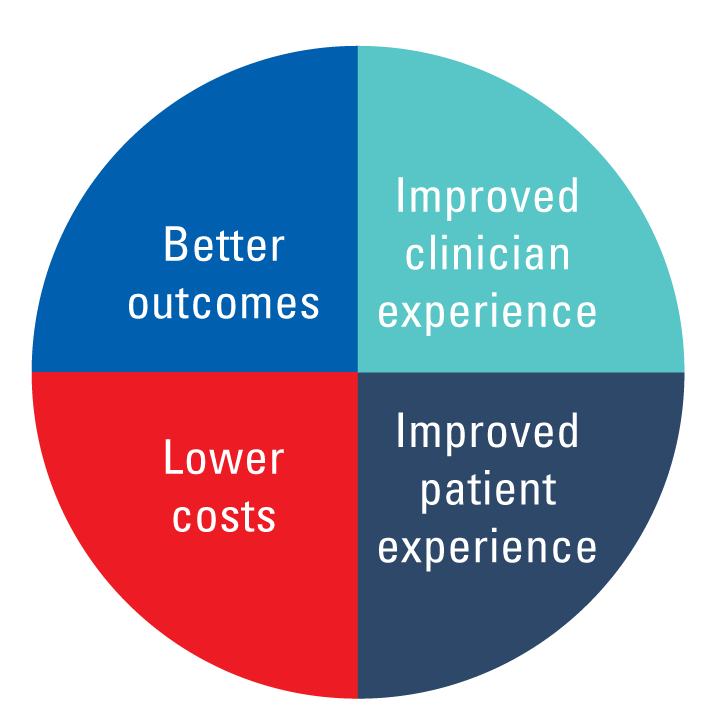Blog
Achieving the quadruple aim: Enhancing healthcare communication to combat clinician burnout

Almost a decade ago, the quadruple aim evolved from the Institute for Healthcare Improvement’s triple aim framework as a foundation to optimize health system performance. This updated guide for healthcare organizations includes the following goals:
- Improved patient experience
- Better outcomes
- Lower costs of care
- Improved clinician experience
In 2019, leading healthcare organizations called physician burnout a public health crisis. In our 2023 State of Healthcare Communications report, almost 80% of healthcare professionals reported that they experience burnout symptoms, although those who felt a great deal of burnout decreased from 21% to 16% within three years (the start of the COVID-19 pandemic). Additionally, the burden of increased workload unrelated to direct patient care consistently stands out as the most significant contributor to clinician burnout.
With COVID-19, healthcare providers faced extraordinary conditions that we had never encountered before. As the global pandemic has subsided, clinician burnout remains an inherent concern in the healthcare industry and affects patient care, healthcare outcomes, and the mental well-being of healthcare professionals.
The seemingly never-ending small frustrations and inefficiencies in many health system communication processes add up to a large opportunity to recover lost time for clinicians. Streamlining these processes can facilitate easier collaboration with the care team and colleagues, ultimately enhancing patient safety and care.
We provide five key questions for healthcare leaders to consider about provider communications within their organizations. These questions can help improve a clinical work environment and support the pursuit of the quadruple aim.
RELATED: The link between the quadruple aim and improved clinical communications >>
1. What is the fastest way for clinicians to contact each other? Is this method available to every member of the care team?
In many hospitals, trying to reach providers usually involves going through an answering service, an operator, or the clinic office. Although some physicians are comfortable sharing their phone numbers with a few colleagues, this approach might not be the most effective—or secure—method of communication. A unified communication platform like Spok Care Connect® provides care team collaboration, closed loop communication, and secure messaging to enhance your hospital or healthcare system’s clinical workflows.
2. Do you send your providers messages that deliver rich, detailed, and actionable information?
If you were on the receiving end of this message: 4-5214, what would it mean to you?
Wouldn’t you rather receive this message instead?
Janet Smith RM 3201 5/2/1927 has a potassium of 3.0. Margaret Jones, RN x4-5212.
Having an established messaging policy and a standardized template allows providers to react and make decisions based on the messages they receive. These messages provide them with the information they need, which allows them to prioritize and take action, eliminating unnecessary phone calls.
3. Have you eliminated unnecessary calls and pages?
Through an enterprise healthcare communication platform, organizations can perform periodic reviews and analytics to determine inappropriate, redundant, and/or unnecessary messages that add no value to the patient care experience and increase provider frustration. It’s possible to eliminate a significant amount of these unnecessary messages to providers by analyzing communication patterns and message content, implementing structured communication templates, and reinforcing proper use of communication tools.
4. Can you eliminate speed bumps so providers quickly can find the right on-call provider?
With constantly changing call schedules, is there a unified, simple way for all your providers to know exactly who to contact, and then be able to quickly communicate with that person? Implementing a unified contact center solution increases operator productivity, reduces costs, and elevates your call center to be the clinical communication hub for your hospital.
5. Is it a challenge to respond to messages and close the communication loop?
Many communication loops can be closed by a simple response, eliminating unnecessary phone calls and the uncertainty that a message may not have been received, viewed, and addressed. Intelligent secure messaging with Spok Care Connect® integrates with provider directory information, clinical systems, the EHR, and on-call schedules to streamline and improve clinical workflows.
Poor clinical communication is often overlooked but can waste providers’ time and cause significant frustration for physicians. Improving clinical communication can greatly reduce provider frustration and burnout. Achieving the goals of the quadruple aim requires thoughtful and comprehensive improvements in communication workflows and technology. These changes can make a meaningful difference. By eliminating daily annoyances and streamlining communications, you ultimately give clinicians valuable time back in their lives.






